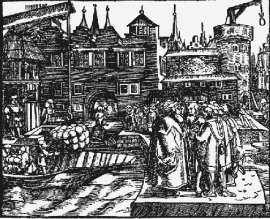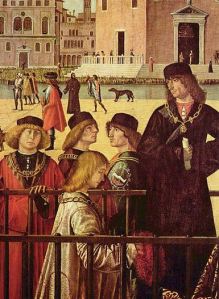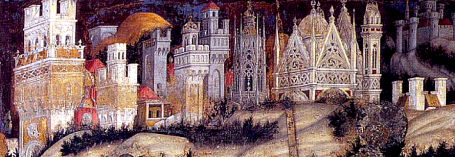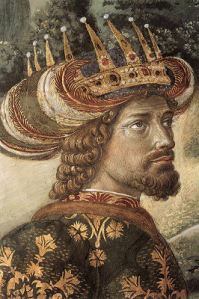Dorothy Dunnett’s books are complicated, dense—hard to read. Intensely rewarding to those who are prepared to make the effort, but I will never blame the reader who tires of the inexplicable events thronging upon one another, bursting with detail and larded with long quotations (often in not only foreign languages, but ANTIQUE foreign languages). Readers just embarking on the series may feel justifiably irked—at times, the book seems to be written in code–and Ms. Dunnett revels in keeping her readers mystified. She is as adept as any detective novel writer in hiding clues, or providing misleading ones.
But that said, the books are quite irresistible to the thinking reader, and as for Lymond himself—HEAVENS, what a dreamboat.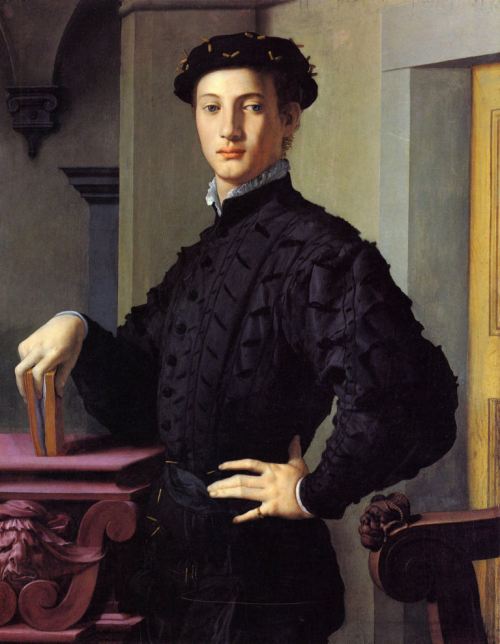 Dorothy dotes on him, and is constantly gloating over his gleaming golden hair, his brilliant blue eyes, his amazing beauty of face and figure. But that is not all! Lymond is an inspired commander of men, a genius at math and music, speaks many languages fluently, has a marvelous gift of invention and a fluent wit. Well. What female can resist these charms? Not me, certainly.
Dorothy dotes on him, and is constantly gloating over his gleaming golden hair, his brilliant blue eyes, his amazing beauty of face and figure. But that is not all! Lymond is an inspired commander of men, a genius at math and music, speaks many languages fluently, has a marvelous gift of invention and a fluent wit. Well. What female can resist these charms? Not me, certainly.
Lymond’s story is firmly set in the whirl and bustle of 16th century Europe: Scotland battling England, England battling France, and the rest of Europe engaged in constant struggles, with each other, with the pope, against the pope–at times joining together to combat Sultan Suleiman. Other times actually joining with him against their neighbors. The demands of trade and the shifting politics of the world were fierce, as they are now, and clever men who could manipulate money and power rose to the top then as they do now. While Lymond is—regrettably—fictional, his world is not, and he has to do with many historical figures, in a very believable solid way.
The six books in the Chronicles span a period of about 15 years; culpably, I didn’t keep track of the years, but Lymond is perhaps 20 in the first book, when he returns to Scotland from exile, and in his mid-30’s at the end of the series. His transformation from a brilliant brittle boy into a brilliant mature and loving man is a main thread in the books, braided into the many other stories. His character is constantly being misprized, maligned, and his characteristic response is keep aloof, allowing the most horrible rumours to build. Indeed, on my last reading I kept thinking, OH COME ON, LYMOND—tell your brother/mother/friend what’s going on. SPIT it out for god’s sake. As he himself says to his brother: “Talk to me, Richard. It isn’t difficult. Move the teeth and agitate the tongue.” Too often something that could have been succinctly explained is left to fester and ghastly outcomes ensue. Which would be the PLOT, do you see, so one shouldn’t complain.
Lymond is haunted by the most extraordinarily wicked villains whose machinations he only manages to thwart after long and painful struggles—death averted at the last minute, torments endured, battles almost lost. The story winds around his attempts to pursue his ambitions despite the constant roadblocks thrown up by a collection of very bad men and women. All 6 books are dense with incident, every page laden with entertainment—and in it all there is the joyful language, the delight in beauty—such descriptions, such scenes! The vocabulary is lush, the world created so real, so engaging.
And how the heart sinks, coming finally to those words, The End.
I have written a summary of the action, here. Of course, it does not detail each event, but even just a broad outline is quite lengthy. I have included the pre-story bits which explain what on earth is going on—be warned that this is a total SPOILER! A collection of quotes is here.
